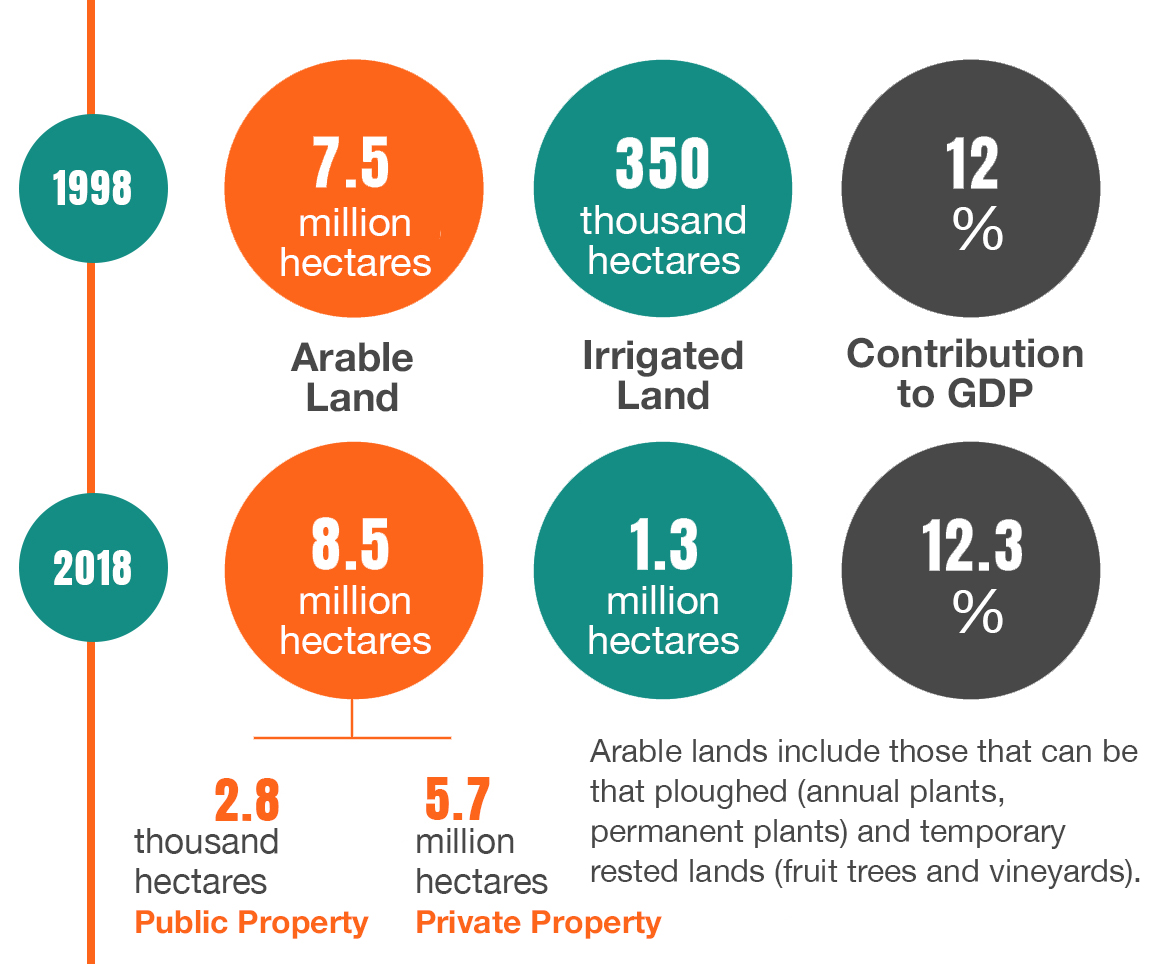
This publication has benefited from the support of the Rosa Luxemburg Foundation. This text may be reproduced in part or in full, provided the source is acknowledged.
In the beginning of August 2018, the cholera epidemic appeared in many Algerian provinces. When it was suspected that the infection had been transmitted through drinking water, attention turned to fruits and vegetables. Moreover, the source of the contaminated products or the commercial route it took to reach the final consumer has not been precisely identified up to now. After two decades of implementing the agricultural development plan, for which a budget of 30 billion dollars was allocated, Algeria is still unable to follow up the course of its agricultural production, and to organize the marketing sector that employs more than 20% of its economically active population, let alone to secure its self sufficiency of the strategic foods such as cereals and milk.
The state of agriculture in Algeria today
After it finally came out of the deadly and horrific nineties, which undermined the limited economic structure that was inherited from the years of “full employment”, Algeria began to revitalize the vital sectors such as agriculture. In the year 2000, which is a year after the beginning of Abdelaziz Bouteflika’s term, the “national plan for agricultural development” was launched. Two years later, its scope had widened to include the support of the rural regions, and its name became “the national plan for agricultural and rural development”. The plan’s basic objective was to secure “the food security of the country.”
Before we go over the achievements and failures of this development plan, we have to state that Algeria was living, at that period, the beginning of the first decade of the new millennium, a state of a substantial food dependency, and relied to a big extent on importing the agricultural products. It was not uncommon to find, in the local market, imported oranges from the Moroccan neighbor or apples and pears imported from France or Spain, although the Mitidja plains near Algiers were known not long ago for their citrus and other fruit trees.
The national agriculture and rural development plan drew several objectives including increasing production (in all agricultural sectors without exception), as well as broadening the area of the arable lands through land reclamation by granting exploitation privileges, reducing the need for importing seeds, developing the systems of production, and using modern irrigation techniques.
To achieve these objectives, Algeria allocated, between 2000 and 2018, huge funds of more than 3000 billion Algerian dinars, which are about 30 billion US dollars.
Ambiguity in the quantification of objectives
In most cases, the objectives of the national agricultural and rural development plan were not accompanied with figures. That is why we cannot precisely access if the goal of broadening the area of the arable lands has been achieved or not and to what extent. Nevertheless, the arable lands which include the lands that can be ploughed (annual crops and temporary rested lands) and other permanent plantings (fruit trees and vines), have increased from 7.5 million hectares in 1988 to 8.5 million hectares in 2018 (5.7 million hectares in private property and 2.8 million hectares owned by the state).
The area of arable lands increased after allowing access to agricultural land through reclamation and encouraging new land exploitations by means of granting exploitation privileges of state-owned agricultural lands to about 200 thousand farmers, as well as granting banking loans that are especially meant for the adoption of modern irrigation techniques. To overcome the fluctuations of the amount of rainfall, the national plan for agricultural and rural development also provided for expanding the irrigated agricultural lands whose area increased from 350 thousand hectares in 1999 to 1.3 billion hectares in the beginning of 2018, that is, from 4% to 15% of the entire arable lands.
In the context of the direct support to the farmers, all agricultural sectors were entitled to receive governmental aid. The general objective was to raise the production of milk and cereals that Algeria spends billions of dollars on importing.

But due to the haste in devising the development program, the lack in monitoring the commitment to the terms of the granted aids while carrying out the project, and the neglect of organizing the sectors and marketing the products, Algeria has missed the chance to acquire the full benefits of the huge allocated investment, especially with respect to the products that still consume a lot of imported materials (seeds, fertilizers, and treatments).
A significant increase in production
There is no doubt that the increase in the productivity of many sectors is one of the tangible results of the national plan for agricultural and rural development. Even though the contribution of the agricultural sector in the gross domestic product did no increase much- from 12% in 2998 to 12.3% in 2018- the agricultural sector now produces an annual sum of more than 3200 billion Algerian dinars in accordance to the latest statistics of the Ministry of Agriculture, Rural Development, and Marine Fishery. Nevertheless, this production value cannot hide the imbalance between the domestic production and the needs of the market that deemed it necessary to increasingly resort to importing, in order to compensate for the shortfall in many products.
This is also the state of cereal cultivation in particular. It has not produced stable results despite all the financial efforts, especially with respect to arable expanding areas and irrigation. We can clearly see this fluctuation in the doubling of the production between two successive seasons. This is what happened in the two agricultural seasons of 2016/2017 and 2017/2018, when the amount of cereals produced rose from 34.7 million quintals to 60.5 million; a record that has not been reached since the beginning of reforming the sector. However, come next season, production might decline, as Algeria has lived this scenario before, in 2013 and 2014. As for the bill of importing cereals, it has risen from 2.77 million dollars in 2017, to 3.1 billion in 2018.
As for the production of legumes, whose importing of around 2 million quintals costs Algeria 150 million dollars annually, it is recording a continuous increase and achieving better results. Its production did not stop increasing since 2008 and until 2018. Its value rose form 402 thousand quintals to 1.3 billion. The Ministry of Agriculture expects to achieve self-sufficiency by 2020.
The same thing applies to the citruses whose annual production continues to increase. It rose from 7 to 14 million quintals within ten years (from 2006 to 2018). Vegetable production also continued to increase, with production more than doubling during that same period (from 60 to 130 million quintals).
On the other hand, the production of dairies is still insufficient, for despite all the efforts that were made, it only covers 50% of the country’s needs. The national production of raw milk rose from 1.2 billion liters in 2000 to 3.5 billion in 2017. During the same period, the quantity of the collected milk rose from 100 to 833 million liters. To compensate for the shortage, Algeria currently imports 400 million tons of powdered milk annually, the cost of which varies in accordance with the quantities imported and the price of powdered milk in the international markets, reaching well over one billion dollars annually (1.4 million dollars in 2017 and 2018).

The dominance of the dealers
With the exception of strategic agricultural sectors, such as cereal and raw milk, which the government buys at incentive prices, even helping the farmers to organize, the rest of the sectors (which produce fruits and vegetables) have been left at the mercy of the speculators and other dealers who now actually dominate the market.
The hegemony of the dealers and speculators could be felt in a stronger manner, when the demand for products soars, such as in the month of Ramadan, when the prices of vegetables and fruits could be multiplied within the scope of 48 hours. But even this hike in prices did not benefit the producers.
From time to time, certain measures have been taken to combat speculation, such as what happened in July 2014 which concurred with the month of Ramadan, when the farmers in the Tipaza province (west of the capital) were empowered to reduce the prices significantly by organizing themselves and selling their products directly to the consumer. However, these measures remain geographically isolated and limited to a certain time, in contrast to speculation, which remains all year long.
With the exception of strategic agricultural crops, such as cereals, and the production of raw milk, for which the government guarantees incentive prices and has even helped the farmers to organize themselves, the rest of the farmers (who produce fruits and vegetables) were left at the mercy of the speculators and the other dealers who now actually dominate the market.
The dealers constitute a chain of irregular active actors where each cuts a margin of the profit, beginning by the producer and ending by the wholesale market. The speculation intensifies in particular during the periods of high demand (the month of Ramadan) or between the seasons of production of products like potatoes in January and February. Moreover, the absence of an organizational framework for the vegetable and fruit sector, and an official price list, facilitated the work of the speculators who provide for the wholesale market, leaving a small margin of profit for the producers.
Arbitrariness runs things
Official statics published towards the end of 2018 revealed that 3.1 million hectares out of 8.5 million hectares of the total arable lands have not been exploited, which is equal to 36% of arable lands. The fact is not surprising knowing that the decision and supervision of aid and the distribution of lands for reclamation are not based on field data. Recently, there has been some talk about several “land owners” giving up their agricultural exploitation- which would not have existed were it not for the government aid - as soon as they have found that they have to pay the costs of their exploitation.
As for the sensitive field of agricultural seeds, Algeria imports about 90% of its needs. This dependency drove Fouad Shahat, the former director of the National Institute for Agronomic Research (INRAA) to say in a recently broadcasted radio program that: “domestic production does not actually secure more than 55% of the food security of Algeria”. He also stated that: “90% of the soft wheat Algeria consumes comes from abroad”. He also believes that “our major weak point has to do with the fact that vegetable seeds and seedlings are imported in their entirety from abroad”.
However, there is also another remark: the tangible improvement in the production of many agricultural products was not accompanied with a similar development in the agricultural-food industry. We had to wait until January 2019, for “The National Interprofessional Council for the Citrus Sector” to be established with the task of “consecrating consultation” between all the stakeholders, namely the producers, exporters, and agri-food, marketing, and storing companies.”
An Incomplete Algerian Symphony
28-02-2021
“The analysis of the National Agricultural Development Plan reveals shortcomings related to the weak anchoring of the plan on the ground. This, in turn, is due to the absence of accurate socio-economic data and a long-term prospective vision for the future of Algerian agriculture.” This is what the National Economic and Social Council (CNES) pointed out in 2001.
Thus, after two decades of reform in the agricultural sector, Algeria is not immune to a return to the state of chronic dependence on food imports that prevailed before the year 2000.
The content of this publication is the sole responsibility of Assafir Al-Arabi and Rosa Luxemburg Foundation cannot accept any liability for it.
Translated from Arabic by Ghassan Rimlawi
Published in Assafir Al-Arabi on 20/05/2019




